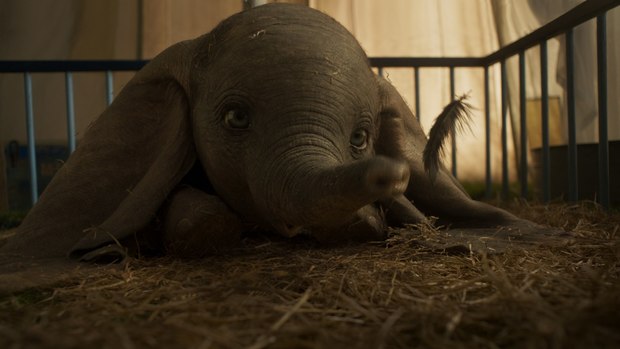In the absence of talking animals, director Tim Burton’s ‘Dumbo’ works in plot points and references to the original film in very clever ways that fans of the original will recognize without feeling forced.

In Disney’s all-new, live-action feature film ‘Dumbo,’ a newborn elephant with oversized ears make him a laughingstock in an already struggling circus. But Dumbo takes everyone by surprise when they discover he can fly. Directed by Tim Burton, ‘Dumbo’ flies into theaters on March 29, 2019. ©2018 Disney Enterprises, Inc. All Rights Reserved.
Disney’s live-action Dumbo is the latest in the studio’s ongoing reimaginings of their classic animated features -- and with Aladdin and The Lion King due out later this year and many more in the pipeline, there’s no sign they’ll be stopping anytime soon (I can’t help but wonder how they’ll turn their “funny animal“ features like Chicken Little or Zootopia into live-action.)
Disney’s reimaginings run the gamut from more or less following the original films’ templates (Beauty and the Beast or Cinderella) to tossing out everything save the title (Pete’s Dragon). Dumbo director Tim Burton’s no stranger to reimaginings himself, with new takes on movies (Planet of the Apes), TV shows (Dark Shadows) and even classic stories (Alice in Wonderland) that range from brilliant to near-misses, to “what was he thinking?”
So where does his Dumbo stand on the twin scales of fidelity and imagination? In my humble estimation, midpoint fidelity-wise; in terms of imagination… this is peak Burton. His affinity for weirdoes and outsiders (Edward Scissorhands, Beetlejuice, etc.) is well-known and on full display in his Dumbo. While the animated original’s focus was on its animal characters with human beings kept in the periphery, in this version the big-eared baby elephant is surrounded by a constellation of (with one or two exceptions) big-hearted humans. In other words, no haughty matronly elephants, no cocky circus mouse, and most definitely no minstrel show crows.
Instead, we have a rag-tag circus of performers and freaks, all portrayed affectionately; they’re a family of outsiders, led by ringmaster Danny DeVito as Max Medici, their crusty but caring father figure. There’s a real father too, Colin Farrell as Holt Farrier, just back from World War I (a title card at the film’s outset lets us know it’s 1919) minus an arm and a wife. Farrier must reconnect with his young son and daughter who’ve been looked after by the circus folk in his absence. Judging from the faded artwork on the circus train’s aged railroad cars it’s obvious Medici’s circus has seen better days. Dumbo’s arrival (via traditional means and not a stork, although a few enjoy a fly-by cameo) sets the plot in motion, as Farrier’s kids bond with the big-eared, blue-eyed baby elephant. (After the “Baby Mine” sequence his mom is sold off -- but don’t worry, she’ll be back.)
In the absence of talking animals, how does Burton’s Dumbo work in plot points and references to the original film? Very cleverly, in ways that fans of the original will recognize without feeling forced, or confusing newcomers meeting Dumbo for the first time. Casey Junior’s engine features a big, wrought-iron smile, a tiny, real-world mouse wearing a ringmaster’s jacket is briefly glimpsed… and “Darling Baby Jumbo” finds himself renamed Dumbo not by a snooty elephant, but via an exceptionally ingenious visual gag I won’t give away here.
Dumbo survives his disastrous initial appearance and becomes the circus’ star attraction in perhaps half the running time of the original… so what can possibly happen next?
“Next” is the arrival of V.A. Vandemere (Michael Keaton), an apparently wealthy impresario who offers Medici a partnership and entrée into the big time in order to get his greedy hands on the baby elephant. This is where Burton’s imagination kicks in full blast as Dumbo and company travel to “Dreamland,” Vandemere’s combination circus and world’s fair. The place is like Coney Island’s actual and long-gone Dreamland or Luna Park on acid, a phantasmagoria of brilliant color and fantasy architecture. (Burton throws in an incongruous shout-out to DisneyWorld’s Carousel of Progress just for the heck of it, and in a nod to Disney’s mighty merchandising powers, a shot of kids snatching up plush doll versions of the movie’s star.)
The crows may be gone, but their song “When I See an Elephant Fly” -- or at least its lyrics -- remain, now orated by Dreamland’s ringmaster as he introduces Dumbo. The pink elephants are still on parade, not as an alcohol-fueled fantasy but as giant soap bubbles created as part of Dumbo’s introduction that take on pachydermous proportions and appearance.
Dumbo’s mom turns up in Vandemere’s zoo, reuniting mother and child. In a somewhat dodgy plot point Vandemere, believing mom will distract his star performer decides to have her destroyed. It might’ve made more sense to hold onto her to keep his star attraction happy, but then the film would be without a big chase and rescue sequence as Medici’s performers team up to free momma. Vandemere’s Dreamland meets the same fiery fate as the real one did a century ago as the film nears its conclusion.
Animal rights activists will cheer the film’s ending, quite different from the original movie (but quite similar to the studio’s live-action Jungle Book) and far more touching. (Get ready for cries of “political correctness” from certain quarters of the media.)
Fun fact: Disney planned a direct-to-video Dumbo sequel that unlike the flying elephant himself, fortunately never got off the ground. The only remnant of it is a three-minute “behind the scenes” featurette on the original film’s initial DVD release. It would’ve featured Dumbo and a cast of new animal characters lost in the big city, but now the world will never get meet twin bear cubs Claude and Molly, the curious zebra Dot, Godfry the hippo or Penny, “the adventurous ostrich” -- unless Disney decides to do it in live-action.















